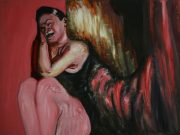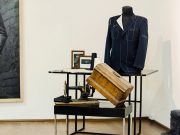From Ukraine with Love: Hollywood’s favorite British spy, James Bond, was inspired by the great Odessa born adventurer.
Everyone knows the world’s most famous secret agent, James Bond. British author Ian Fleming’s hero has been a box office star for more than half a century. Bond is celebrated around the globe for his brilliant mind, wild adventures, and debonair charm. “Women want him, and men want to be him”. What most people don’t know is that James Bond has his origins in Odessa, Ukraine.
James Bond is a fictitious character, but he was inspired by real people. Before writing the first James Bond book, author Ian Fleming had a successful career in Britain’s Secret Intelligence Service (SIS). This work gave Fleming the background he needed to write the Bond series of novels. Many of the plot devices and personalities featured in the series closely mirror Fleming’s personal experiences. However, the primary inspiration for the character of James Bond actually came from an era before Fleming’s own. James Bond was inspired by the incredible life story of a man born in Odessa on March 24, 1874, under the name Sigmund Rosenblum.
Rosenblum, who would later assume the more English-sounding name of Sidney Reilly, lived a life shrouded in intrigue and mystery. In fact, it is still difficult to discern which parts of Reilly’s life are historical fact, and which parts are mere legend. There is broad agreement over some of his most audacious escapades: observers generally believe he really did deliver the Persian oil fields to the British crown. He is credited with stealing Germany’s top naval secrets, and came within a whisker of assassinating Vladimir Lenin in 1918 as part of the Lockhart Plot.
Officially, Sigmund Rosenblum (aka Sidney Reilly) was born the son of Grigory, who was a wealthy Jewish contractor in Odessa. However, in later life Reilly would claim his real father was Grigory’s first cousin, a medical doctor named Mikhail Rosenblum. Only Reilly’s mother Polina, who was a professional pianist (and possibly a distant cousin of Russian nobility), knew for sure. What is more certain is that his family’s home was located at 15 Aleksandrovskiy Prospect near Greek Square (Grecheskaya Ploshcha) in the city.
Reilly began his political and espionage work in Odessa on behalf of the Friends of Enlightenment, a Jewish emancipation movement that sought the right of the Jewish community to fully integrate into society. Working as a messenger for this secret group led to his arrest by the tsarist secret police, known as the Okhrana, in 1892. Having already been arrested by the age of 18, Reilly understood his future in Russian Empire would be limited. Shortly thereafter, Reilly faked his own death by staging a drowning in Odessa harbor. He then caught a British ship sailing to Brazil. Apparently, Reilly befriended some British explorers on the ship, and he started working as their cook. Once in Brazil, Reilly claims to have saved the explorers from cannibals. Following this act of heroism, the leader of the group awarded Reilly with a British passport and 1500 pounds – a substantial sum at the time. However, in another version of the story, after faking his death in Odessa, Reilly robbed a pair of French couriers (or murdered a pair of Italian anarchists in another version) and used their money and passports to eventually arrive in Britain.
Once in London, Reilly established Rosenblum and Company, a pharmaceutical company. He quickly became a fixture in London’s Russian émigré community and developed a taste for lavish living. Reilly’s prominence in the Russian community caught the attention of Scotland Yard, who began paying him as an informant. Like James Bond, the charismatic Reilly proved irresistible to women. He aided by making connections in the Russian community through his romantic relationship with Ethel Voynich, the wife of the Polish revolutionary Wilfred Voynich (owner of the mysterious Voynich Manuscript). Reilly would later confess to Ethel about his life of espionage and intrigue, which gave the famous Victorian writer an idea for her novel “The Gadfly”, which was loosely based on Reilly’s real life exploits. By 1896, Reilly’s value as an informant had increased dramatically. He was recommended to British intelligence for overseas work.
In 1897, Reilly began a secret affair with the 24-year-old wife of Reverend Hugh Thomas. Reverend Thomas, age 63, regularly purchased medicine from Reilly’s pharmacy to treat a kidney disease. When the reverend suddenly died, Reilly married Margaret Thomas, his young widow in August 1898. Margaret Thomas inherited a substantial fortune, helping to pay for Reilly’s increasingly expensive lifestyle. A year after his marriage to Margaret, he decided to change his name from Rosenblum to his wife’s maiden name “Reilly”. Reilly’s rationale for the name change was, “in Europe, only the British hate the Irish, but everyone hates the Jews”. Though he never divorced Margaret, Reilly would have numerous romances with women on three continents. In addition to Margaret, Reilly maintained a romantic lifelong relationship with a distant cousin from Grodno (modern-day Belarus) named Felitsia. One colleague in British intelligence said of Reilly’s womanizing ways, “he has eleven passports, and a wife to match each one.”
With his new wealth, knowledge of six languages, and proven record with Scotland Yard, Reilly was tasked with greater responsibilities. The same year as he changed his name, Reilly was in Holland disguised as a Russian arms dealer who reported to London about Dutch weapon supplies to South Africa during the Second Boer War. During the Russo-Japanese War, Reilly popped up in Port Arthur, Manchuria (China) as a timber salesman in early 1904. In Port Arthur, Reilly may have worked as a double (and some say even quadruple) agent for the British and Japanese. What is clear is that Reilly co-opted a Chinese spy to give the Japanese (and British) the Russian plans for defense of the harbor. This led to a surprise attack at night by the Japanese navy and the deaths of 31,000 Russian soldiers.
Reilly rose to prominence in the ranks of British intelligence for his work in the D’Arcy Affair. Having previously visited Baku, Azerbaijan (then part of Persia) in 1902 to investigate the oil sector, Reilly was aware of the vast energy resources of the country. The British Board of the Admiralty had made a decision in 1904 to change the main fuel supply for the Royal Navy from coal to oil, making steady oil supplies a strategic priority. Reilly had learned from his contacts close to the Persian Shah that the country’s oil field concessions had been granted to an Australian named William Knox D’Arcy. D’Arcy then traveled to France to negotiate a sale and/or lease of the concessions to the wealthy Rothschild family. During negotiations on Lord de Rothschild’s yacht near Cote d’Azur on the French Riviera, Reilly disguised himself as a Catholic priest collecting charitable donations in order to gain entry to the boat. Interrupting the dinner between Rothschild and D’Arcy, Reilly was able to lure D’Arcy away privately for a few minutes. During those tense minutes, Reilly revealed his true cover and, using his great charm and charisma, he persuaded D’Arcy that the British would offer more than the Rothschild family. The daring gamble worked. With D’Arcy’s concessions on the Persian oil fields, the British obtained the oil supplies they needed to fuel their famous Royal Navy. As a result of having a reliable purchaser, Azerbaijan would be the world’s largest oil producer for the next two decades.
Reilly’s career would continue to benefit the British. In 1909, he appeared as a Baltic welder at the Krupp factory in Essen, Germany. Using his access to the factory and lock-picking skills, he discovered the company’s top secret weapon designs and made copies for his bosses in London. This information would be vital at the onset of World War I five years later. The same year, Reilly had an affair with Eve Lavalliere, the wife of the Director of the Parisian Theatre de Varieties.
Reilly continued to help the British against the Germans. In 1911, he traveled to Russia and infiltrated a delegation from the German Blohm and Voss shipbuilding firm who were trying to negotiate the sale of German naval vessels to Russia. Having already seduced the wife of the Russian Minister of Marine, Reilly used his access to the minister’s home to persuade the gullible minister to award the contract for rebuilding the Russian fleet to Blohm and Voss. This deal not only made Reilly a huge commission, but it also gave him access to the secret German naval designs, which he shared with the British. Using part of his commission, Reilly then paid the Russian minister to divorce his wife Nadezhda Zalessky, so that he could marry her himself. The same year he amicably divorced Nadezhda, and then started an affair with 18-year-old Caryll Houselander. However, in 1923 he married Pepita Bobadilla, a Latin actress he had met in Berlin.
Reilly next pops up in New York in 1914, where he opened an office at 120 Broadway Street. In the Big Apple, Reilly countered German attempts to sabotage American supplies to France and Britain. He also orchestrated the lucrative purchase and supply of American goods to support the Russian army against Germany. It was in New York that Sidney started a relationship with model Beatrice Tremaine. The same year, in 1916, Reilly ran the British underground in German-occupied Poland while based out of the Bristol Hotel in Warsaw. In October 1917, Reilly moved to Canada to join the British Royal Flying Corps. Reilly then parachuted behind German lines to conduct acts of sabotage and espionage in order to support the Allied war effort. According to popular legend, he even managed to disguise himself as a German officer and infiltrate a meeting attended by Kaiser Wilhelm himself.
With the murder of Tsar Nicholas by the Bolsheviks, the British government worried that the new Communist government would sign a separate peace treaty with Germany. Reilly was sent to Russia in February 1918 with the Herculean task of keeping Russia in the war against Germany. Reilly and fellow secret agent Robert Lockhart began orchestrating British government financial support for an army of anti-Bolsheviks led by Boris Savinkov, a former official in the Russian provisional government. Reilly, this time posing as a Turkish merchant, began systematically bribing the Latvian bodyguards that protected Vladimir Lenin and Leon Trotsky. Reilly’s plan was to have the Latvian guards turn the two Communist leaders over to him in exchange for money. Reilly either planned to kill Lenin himself, or to parade the two revolutionaries naked through the streets of Moscow, in order to humiliate and discredit them in the eyes of the Russian public. Simultaneously, Savinkov and his army of counter-revolutionaries would seize power to replace Lenin and Trotsky, and Reilly would play the role of grey cardinal.
The scheme was foiled at the eleventh hour. A French journalist betrayed the plot to the Bolsheviks, while a failed assassination attempt against Lenin by Dora Kaplan further upset Reilly’s plans. “I was a millimeter from being able to become the ruler of Russia,” said Reilly about the events. To avoid arrest, Reilly first disguised himself as a Cheka officer (Bolshevik secret police), and later as a legal clerk traveling on a forged German passport, which allowed him to escape via Finland. Neither Lockhart nor two of Reilly’s mistresses (one of whom, Olga Starzhevskaya, was a mole inside the Cheka) were quite as fortunate. Lockhart was arrested and held in prison before being swapped for a Russian spy. The mistresses were also arrested and disappeared from history (likely killed). Though Reilly was the ringleader, the events became known as the Lockhart Plot, which resulted in a Red Terror of arrests and executions of suspected conspirators. Reilly was sentenced to death in absentia by a Bolshevik court in November 1918.
This setback did not prevent Reilly from returning to his native Odessa. The legendary spy spent February to April of 1919 in his hometown, living in disguise as a British diplomat. While in Odessa, Reilly published several anonymous anti-Bolshevik letters to the editors of local newspapers and recruited agents among the Odessa elites. He also met Odessan Grigoriy Kotovskiy (a former underworld ‘thief in-law’ companion of Misha Yaponchik) who would later become a Red Army General. Naturally, Reilly’s love of women continued, and he was seen meeting with actress Vera Holodnaya in the bar of the Londonskaya Hotel on Primorskiy Boulevard. Reilly also spent time with his aging mother, who was living on Trinity Street next to the British Consulate by this time (perpendicular to Aleksandrovskiy Prospect).
Upon his return to the UK, Reilly became an adviser on Russian affairs to Winston Churchill. The two men found common ideological ground in their opposition to Bolshevism. Around this time, Reilly published an article in which he branded Bolshevism, “a cancer that affects the foundations of civilization…an arch enemy of the human race…the power of the Anti-Christ. At any cost, this abomination…must be destroyed…there is only one enemy. Humanity must unite against this midnight terror.” In 1921, Reilly was ‘officially’ dismissed as a British agent, although that may have been a legend to protect both Reilly and the British government.
Using his wealth (and likely British government funding), Reilly began supporting several anti-Bolshevik groups inside Russia. One of the groups, known as The Trust, was successful in raising money from White Russians in Europe, because it claimed to have high-ranking officials embedded within the Bolshevik government. However, The Trust was a cover operation for the OGPU, the successor of the Cheka and the forerunner of the NKVD (Russian intelligence). The Trust invited Boris Savinkov to Russia to meet with the counter-revolutionaries. Upon his arrival in Russia, he was arrested by the OGPU. Savinkov was soon executed.
To get revenge, Reilly penned the Zinoviev Letter. At the time, Britain’s Labour Party government had just recognized the Soviet Union and was about to provide them with huge financial loans. Reilly’s forged a letter from high-ranking Soviet official Grigoriy Zinoviev to the British Communist Party calling for, “the revolutionizing of the British proletariat.” The Zinoviev Letter caused uproar after it was leaked to the media. The scandal led to the defeat of the Labour Party government in the October 1924 elections. A month later, the new Conservative-led government canceled the unratified treaty with the Soviets, and the United States subsequently postponed recognition of the Soviet Union by several years. Having become a true mover of world events, Reilly said, “it is a fake, but it is the result that counts.”
In September 1925, despite the murder of his friend Savinkov, Reilly surprisingly accepted an invitation from The Trust to visit the Soviet Union. He mailed a postcard from Moscow on 27 September to a colleague in British intelligence stating merely “all is fine” before disappearing. Reilly’s disappearance became front-page news in Britain and there was wild speculation about his whereabouts. The Soviets claimed Reilly had been killed trying to escape to Finland. For years, there were alleged sightings of Reilly in different parts of Europe. British intelligence worried that Reilly may have switched sides and made a deal with the Soviets. Finally, in 2002, a former OGPU colonel confessed to the murder of Reilly. The killing took place in November 1925. The self-confessed executioner claimed to have been acting under direct orders from Joseph Stalin who wanted retaliation for the Lockhart Plot.
Why was Ian Fleming so captivated by the legend of Sidney Reilly? He could hardly have had a better introduction to the colorful world of Sidney Reilly. Lockhart himself shared his personal experiences and knowledge of Reilly with Ian Fleming. As a fellow British agent, Fleming was already well aware of Reilly’s reputation for daring adventures. He used the first-hand accounts provided by Lockhart to create the character of James Bond for his novels. Once, when asked about his inspiration for the wild plots in the Bond novels, Fleming responded, “James Bond is just a piece of nonsense I dreamed up. He’s not a Sidney Reilly you know!”
It is quite fitting that an Odessa native should be the inspiration behind James Bond. After all, Odessa has produced a range of flamboyant fictional characters and literary legends such as Ostap Bender, Benya Krik, and Rabinovich. For centuries, Odessa has fired the imagination. It is only natural to learn that the city’s cosmopolitan climate helped inspire some of the greatest spy stories ever told. James Bond may be a global figure, but his charisma, cunning, aristocratic tastes, and appetite for danger are quintessential Odessa traits.
I hope this article has left you shaken and not stirred. The next time you watch a James Bond movie, you now may find it difficult to forget that the debonair hero was actually inspired by an Odessa adventurer. In reply to the character’s legendary “Bond, James Bond” introduction, Ukrainian viewers might even be excused for answering, “Mama, Odessa Mama.”
Brian Mefford is a political analyst and consultant based in Kyiv since 1999. A former Director of the International Republican Institute (IRI). He was an adviser to President Viktor Yushchenko. He is currently a Senior Non-Resident Fellow for the Atlantic Council.





































Pingback: James Bond - From Odesa with Love()